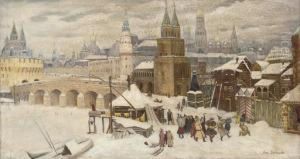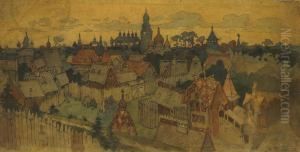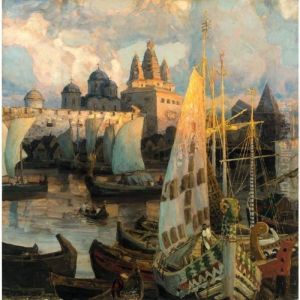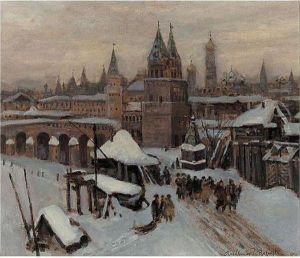Apollinarii Mikhailovich Vasnetsov Paintings
Apollinarii Mikhailovich Vasnetsov was a Russian painter and graphic artist, whose work was deeply connected with historical and fairy-tale subjects. Born on August 25, 1856, in the village of Ryabovo in the Vyatka province (now Kirov region), he was the younger brother of the famous Russian painter Viktor Vasnetsov. Apollinarii Vasnetsov initially received his education at home and later attended the Vyatka gymnasium. Unlike his brother who was predominantly focused on mythological themes, Apollinarii was largely interested in historical reconstruction.
Vasnetsov moved to Moscow in 1872, where his brother Viktor was already an established artist. Under the influence of his brother, he began to study painting, although he never received a formal art education. Instead, he learned through observation and practice, working closely with his brother and other artists of the time. Apollinarii was particularly influenced by the works of the Wanderers (Peredvizhniki), a group of Russian realist artists who formed an artists' cooperative in protest against academic restrictions.
Throughout his career, Apollinarii Vasnetsov became known for his historical paintings, which were characterized by their accuracy and attention to detail. His works often depicted medieval Moscow and were based on rigorous historical research. Vasnetsov undertook extensive travels across Russia to study ancient architecture and artefacts, which helped him recreate historical scenes with authenticity.
In addition to his historical paintings, Vasnetsov also worked on graphic art and was involved in stage design, where he applied his meticulous approach to historical accuracy. He was a member of several art societies, including the Association of Travelling Art Exhibitions (the Wanderers) and the Moscow Society of Lovers of the Arts.
Vasnetsov's contribution to Russian art was recognized during his lifetime, and he was awarded the title of Honored Artist of the RSFSR. He passed away on January 23, 1933, in Moscow, leaving behind a legacy of work that continues to be appreciated for its portrayal of Russian history and culture.




















